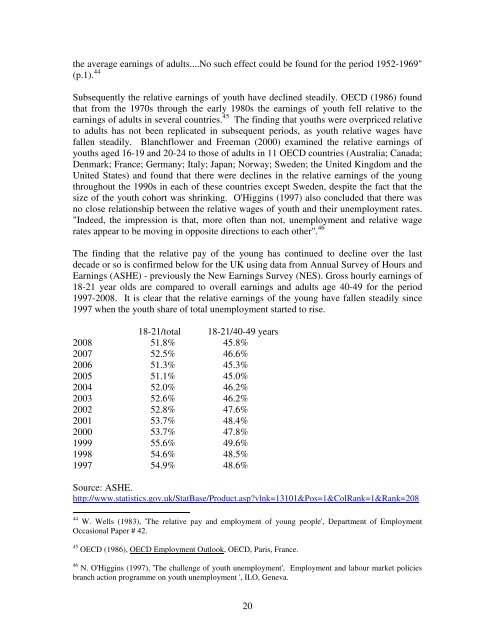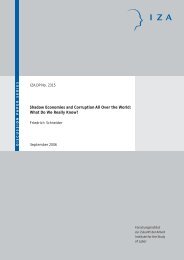Youth Unemployment: Déjà Vu? - Index of - IZA
Youth Unemployment: Déjà Vu? - Index of - IZA
Youth Unemployment: Déjà Vu? - Index of - IZA
You also want an ePaper? Increase the reach of your titles
YUMPU automatically turns print PDFs into web optimized ePapers that Google loves.
the average earnings <strong>of</strong> adults....No such effect could be found for the period 1952-1969"<br />
(p.1). 44<br />
Subsequently the relative earnings <strong>of</strong> youth have declined steadily. OECD (1986) found<br />
that from the 1970s through the early 1980s the earnings <strong>of</strong> youth fell relative to the<br />
earnings <strong>of</strong> adults in several countries. 45 The finding that youths were overpriced relative<br />
to adults has not been replicated in subsequent periods, as youth relative wages have<br />
fallen steadily. Blanchflower and Freeman (2000) examined the relative earnings <strong>of</strong><br />
youths aged 16-19 and 20-24 to those <strong>of</strong> adults in 11 OECD countries (Australia; Canada;<br />
Denmark; France; Germany; Italy; Japan; Norway; Sweden; the United Kingdom and the<br />
United States) and found that there were declines in the relative earnings <strong>of</strong> the young<br />
throughout the 1990s in each <strong>of</strong> these countries except Sweden, despite the fact that the<br />
size <strong>of</strong> the youth cohort was shrinking. O'Higgins (1997) also concluded that there was<br />
no close relationship between the relative wages <strong>of</strong> youth and their unemployment rates.<br />
"Indeed, the impression is that, more <strong>of</strong>ten than not, unemployment and relative wage<br />
rates appear to be moving in opposite directions to each other". 46<br />
The finding that the relative pay <strong>of</strong> the young has continued to decline over the last<br />
decade or so is confirmed below for the UK using data from Annual Survey <strong>of</strong> Hours and<br />
Earnings (ASHE) - previously the New Earnings Survey (NES). Gross hourly earnings <strong>of</strong><br />
18-21 year olds are compared to overall earnings and adults age 40-49 for the period<br />
1997-2008. It is clear that the relative earnings <strong>of</strong> the young have fallen steadily since<br />
1997 when the youth share <strong>of</strong> total unemployment started to rise.<br />
18-21/total 18-21/40-49 years<br />
2008 51.8% 45.8%<br />
2007 52.5% 46.6%<br />
2006 51.3% 45.3%<br />
2005 51.1% 45.0%<br />
2004 52.0% 46.2%<br />
2003 52.6% 46.2%<br />
2002 52.8% 47.6%<br />
2001 53.7% 48.4%<br />
2000 53.7% 47.8%<br />
1999 55.6% 49.6%<br />
1998 54.6% 48.5%<br />
1997 54.9% 48.6%<br />
Source: ASHE.<br />
http://www.statistics.gov.uk/StatBase/Product.asp?vlnk=13101&Pos=1&ColRank=1&Rank=208<br />
44 W. Wells (1983), 'The relative pay and employment <strong>of</strong> young people', Department <strong>of</strong> Employment<br />
Occasional Paper # 42.<br />
45 OECD (1986), OECD Employment Outlook, OECD, Paris, France.<br />
46 N. O'Higgins (1997), 'The challenge <strong>of</strong> youth unemployment', Employment and labour market policies<br />
branch action programme on youth unemployment ', ILO, Geneva.<br />
20
















